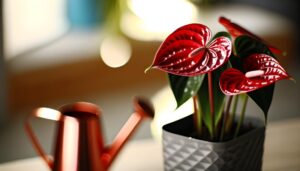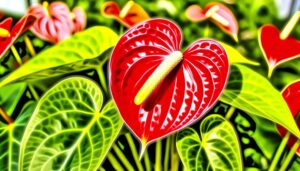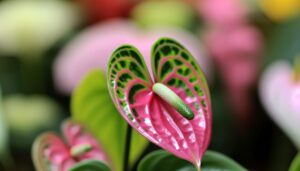Complete Guide to Caring for Anthurium Evita Pink
Caring for Anthurium Evita Pink involves precise conditions. Guarantee bright, indirect sunlight, ideally near an east or north-facing window, or use artificial grow lights.
Water thoroughly with tepid, filtered water once the top inch of soil is dry, and maintain humidity above 60% using a humidifier or humidity tray. Employ a well-aerated soil mix with orchid bark, perlite, and peat moss or coco coir.
Keep temperatures between 65°F and 80°F, and avoid drops below 55°F. Vigilantly manage pests like spider mites and mealybugs, and prevent root rot by ensuring proper drainage.
Discover more advanced techniques for ideal care.

Key Takeaways
- Provide bright, indirect sunlight by placing near an east or north-facing window.
- Water thoroughly when the top inch of soil is dry, using tepid, filtered water.
- Use a well-aerated, fast-draining soil mix with orchid bark, perlite, and peat moss.
- Maintain temperatures between 65°F to 80°F and keep humidity levels above 60%.
- Monitor and manage common pests such as spider mites and mealybugs with integrated pest management strategies.
Optimal Lighting Conditions
To guarantee the Anthurium Evita Pink thrives, it is crucial to provide bright, indirect sunlight, as direct exposure can cause leaf scorch and inhibit growth. Best lighting conditions involve placing the plant near an east or north-facing window where it can receive filtered light.
Avoid positioning it in direct sunlight or overly shaded areas, as both extremes can be harmful. If natural light is insufficient, consider using artificial grow lights, making sure they are set to mimic natural daylight cycles. Utilizing sheer curtains can soften intense sunlight, preventing potential photodamage.
Regularly rotate the plant to ensure even light distribution, promoting symmetrical growth. Monitoring light intensity using a light meter can further guarantee ideal conditions are consistently maintained.
Watering Requirements
Maintaining ideal moisture levels for the Anthurium Evita Pink necessitates a careful balance, ensuring the soil remains consistently moist but not waterlogged.
Water the plant thoroughly, allowing excess water to drain completely to prevent root rot. Utilize tepid, filtered water to avoid potential mineral buildup and chlorine damage.
Frequency of watering may vary based on environmental conditions; however, a general guideline is to water when the top inch of soil feels dry to the touch.
Employ a humidity tray or room humidifier to maintain ambient humidity levels around 60-80%, which is crucial for best growth.
Regularly monitor the plant for signs of over- or under-watering, such as yellowing leaves or wilting, and adjust your watering regimen accordingly.
Ideal Soil Mix
An ideal soil mix for Anthurium Evita Pink should be well-aerated, fast-draining, and rich in organic matter to support robust root development and prevent waterlogging.
A recommended composition includes a blend of one part orchid bark, one part perlite, and one part peat moss or coco coir. Orchid bark promotes excellent aeration, while perlite facilitates drainage and prevents soil compaction. Peat moss or coco coir aids in moisture retention and nutrient availability.
Incorporating activated charcoal can further enhance soil health by improving drainage and reducing odor. It is crucial to avoid heavy, clay-based soils that retain excessive moisture, as they can lead to root rot.
Regularly checking and renewing the soil mix ensures ideal growing conditions.
Temperature and Humidity
Alongside providing a best soil mix, maintaining appropriate temperature and humidity levels is essential for the thriving growth of Anthurium Evita Pink. Optimal temperature ranges between 65°F to 80°F (18°C to 27°C).
Avoid exposing the plant to temperatures below 55°F (13°C), as it can cause growth stagnation and leaf damage.
Consistent humidity levels above 60% are recommended. Utilize a humidifier or place the plant on a humidity tray to achieve this. Regular misting with distilled water can further enhance humidity.
Ensure proper ventilation to prevent fungal growth without creating drafts. Temperature and humidity stability are critical for the physiological processes and overall health of Anthurium Evita Pink, fostering robust foliage and vibrant blooms.
Common Pests and Diseases
Vigilant monitoring for common pests and diseases is essential to safeguarding the health and robustness of Anthurium Evita Pink. Regular inspections are critical for early detection and intervention.
Key pests and diseases include:
- Spider Mites: These minuscule arachnids cause stippling on leaves and can be controlled using miticides or insecticidal soaps.
- Mealybugs: Identified by their cotton-like appearance, they can be eradicated with neem oil or alcohol-soaked cotton swabs.
- Root Rot: Often due to overwatering, it requires proper drainage and possibly fungicidal treatment.
- Bacterial Blight: Manifests as water-soaked lesions; manage through pruning affected areas and applying bactericides.
Implement integrated pest management (IPM) strategies to maintain a healthy growing environment and minimize chemical intervention.
Conclusion
In sum, providing ideal lighting conditions, adhering to specific watering requirements, using a perfect soil mix, maintaining suitable temperature and humidity, and vigilantly monitoring for common pests and diseases are crucial for the successful cultivation of Anthurium Evita Pink.
Each factor works together to the plant's overall health, ensuring strong growth and colorful blooms.
Mastery of these elements fosters an environment conducive to the flourishing of this specific anthurium species, highlighting the importance of thorough care and attentive maintenance.






